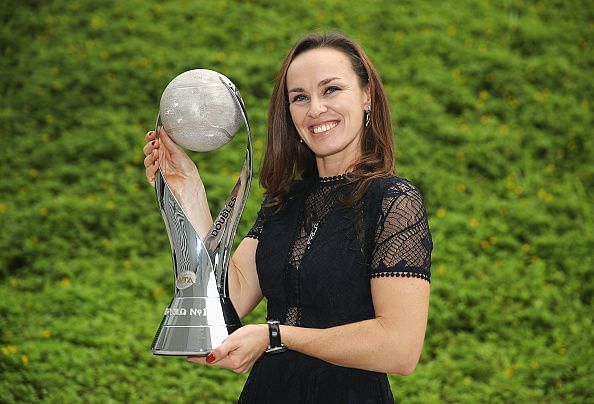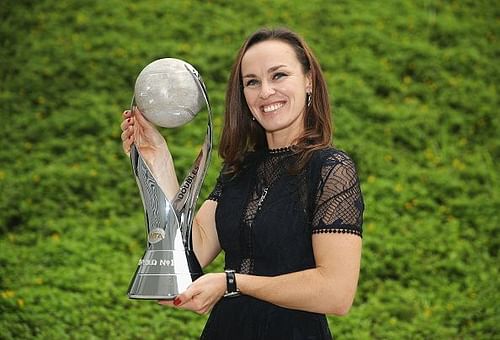
Martina Hingis: A flawed genius if ever there was one

For a player whose very name was down to the brilliance of another, Martina Hingis sure didn't take a lot of time to create a unique identity of her own.
She was named after the legendary Martina Navratilova, but by the 17th year of her life she was the only Martina that the tennis world cared about. Her playing style was nothing like that of her fellow Czech World No. 1 (Hingis, like Navratilova, was born in the erstwhile Czechoslovakia). In fact, so special was her game that very soon people looked, in vain, for the 'next Hingis' - a player who could run circles around her opponents with little more than a dab and a smirk.
When the now Swiss national announced her third - and you suspect, final - retirement from tennis, that was the first thing that came to my mind: her chess-like, eclectic game, and how much we're going to miss it. It may not have been the most successful game - although in 1997 it did look likely to take her to a GOAT career - but it was probably the most nightmare-inducing for WTA players in the last two decades.
There were other things about Hingis that induced nightmares too. Her infamously tart tongue has been known to make people wonder, in turns, whether she was an overgrown child or an adult who never grew up.
Yes, it must have been tough for a 16-year-old to come to terms with the fact that she was the very best in the world at what she did for a living. All that fame, all that adulation, all that attention - which teenager you've ever known has been equipped to handle those kinds of things with anything approaching equanimity?
Hingis' PR team must have spent hours together trying to teach her how to not act her age. And the Swiss Miss' only real crime may have been failing to keep her emotions in check at a time when you can't possibly be expected to keep your emotions in check. But unfortunately for her, the reams of newsprint are set in stone.
When she reportedly called openly gay player Amelie Mauresmo 'half a man' back in 1999, she may not have even fully understood the ramifications of her comment. She was quick to refute the reports, of course, and even quicker to demolish Mauresmo in the Australian Open final played just a day later. But her homophobic image has stuck.
She also somehow contrived to add racism to her list of perceived faults. In 2001 she claimed that Venus and Serena Williams got preferential treatment from sponsors because they were black. And when told of the backlash her comment had inspired, she gave the ultimate back-handed apology by saying she was sorry for being 'politically incorrect'.
You'd think the fear of being branded a racist AND a homophobe would be enough to make anyone temper their forthrightness, but Hingis had already gone past all that. In 1999 she said the then 29-year-old Steffi Graf, the legend to beat all legends, was past her prime. And then she went ahead and did the unthinkable: she not only lost to Graf in the French Open final, but she tried taking on the French crowd while she was at it.
Hingis whined, she stuck her tongue out, she went over to Graf's side of the net to inspect a line call, and she even hit a couple of under-arm serves. If anyone in the crowd was on her side before the match began, Hingis ensured that wouldn't be the case by the time it ended.
Court Philippe Chatrier can feel like a cauldron of emotions at the best of times, and a cascade of blood-thirsty boos at the worst. Hingis was 18 at the time, so it's perhaps understandable that she was moved to tears by the negativity of it all. What is not understandable, however, is why she continued disregarding convention and wisdom as the hostile reception kept intensifying.
After the match Hingis wanted to skip the presentation ceremony - a cardinal sin in the genteel sport of tennis. She only attended it because her mother Melanie Molitor - who was also her coach - urged her to do so.
And that is essentially the crux of the Hingis story: she was practically a child, who needed to be chaperoned by an experienced adult. But she was a child who was also a five-time Grand Slam champion, and that made her shenanigans unforgivable in the minds of most tennis followers.
Was Hingis made to pay too high a price for her success? An argument could be made that she was judged too harshly while she was still in her teens, but another argument is that there's a reason trouble never left her even when she outgrew her pimple-faced years.
In 2007 - well after she had retired and subsequently un-retired from the sport - she tested positive for cocaine, thus hastening her second retirement from the sport. She claimed she never took the drug, but in the same breath refused to contest the two-year ban imposed on her by the ITF. As she crawled into the sunset, tennis followers everywhere asked themselves just one question: why didn't she fight if she was innocent?
We never got the answer to that. But in 2013, just after her second comeback to the sport, Hingis was in the news again - this time for allegedly being a serial adulterer. Her then husband Thibault Hutin claimed that Hingis had a 'very personal conception of morality', and that she had repeatedly cheated on him and all her previous boyfriends.
Despite the mild furor that Hutin's comments caused, Hingis was still inducted into the International Tennis Hall of Fame that same month. But two months after that, things took a turn for the uglier; Hingis now stood accused of domestic violence. Hutin alleged that she and her mother beat him up and threatened to 'set the Russians on him', thus permanently destroying any goody-two-shoes image that anyone in the world may have had of the Swiss Miss.
The allegations were never proven, so it's possible that Hingis may have been innocent of these crimes too. Fortunately for her though, she didn't have to try too hard to make people forget about all that sordidness; she could let her tennis do the talking once again.
To say that Hingis' third career was a wild success would be an understatement. After returning to the tour in 2013, she won 10 Slams in a five-year period - four in doubles and six in mixed doubles - along with an Olympic silver medal and a year-end championship. She played a huge role in making Indian tennis relevant again, as she partnered Sania Mirza in doubles and Leander Paes in mixed doubles to establish yet another reign of dominance.
And it was in this late-career renaissance period that her magical skills truly came to the fore, without all the drama and baggage of her early years. With the spotlight burning on her a little less brightly as she waded through the second-tier format of the sport, she brought all of her guile and dexterity to bear on her befuddled opponents, who were probably left cursing the day she made her return.
Hingis was never a net-rusher during her singles career, which makes her volleying skills as a doubles specialist all the more remarkable. She hit a two-handed backhand volley, which is usually the preserve of players grossly uncomfortable at the net, but the angles and bite she got with it could put any flamboyant one-hander to shame.
Then there was her sense of anticipation, which frequently made us wonder whether she had some kind of cheat code that allowed her to enter the minds of her opponents. Somehow, Hingis almost always knew which direction you were going to go - and she made you pay the price for it.
This point from the 2016 Wimbledon championships depicts her otherwordly anticipation better than anything else. I have watched this clip at least 20 times, and to this day I have no idea how she managed to get into the exact right position for that final backhand winner.
Her recent doubles success was so authoritative that it almost started looking unfair. When she and Roger Federer announced their intention of partnering for the mixed doubles competition at the 2016 Rio Olympics, there was a feeling in the tennis world that it would be easier to just hand them the trophy. Federer's injury prevented the dream team from taking centrestage, but Hingis still took home some silverware - literally at that. She and Timea Bacsinszky won the silver medal in women's doubles, making it another successful foray for the already mega-successful star.
There was a saying in the 80s that the best doubles team in the world was John McEnroe with anyone else. That seemed in danger of being changed to: the best doubles team in the world is Martina Hingis with anyone else.
The Swiss won big in her third and last career, and her insatiable hunger for success helped bring some much-needed limelight to doubles. More than anything though, it reminded us how she became a champion in the first place.
Hingis was many things - artist, megalomaniac, sabre-tongued vixen - but underneath all of that she was an athlete who hated to lose. I remember how I repeatedly requested for an interview with her during the 2016 US Open, and how after about three days of my nagging she finally agreed. But on the day of the interview she ended up losing her mixed doubles match, and that made her so upset that she cancelled all interview requests for the rest of the tournament.
It is that hatred of failure, which was often converted into an unshakeable desire to win, that helped Hingis achieve all that she did through her multiple careers. She wasn't unlike Serena Williams in that regard; they both thought they were better than everybody else, and that it was their birthright to win everything in sight. And they both also did win everything in sight, at least for a while.
Sure, the things that made Hingis different from the rest - her touch, her finesse, her court smarts - weren't enough to make her as great a champion as Serena. But they were no less important in shaping the history of women's tennis, as they taught a generation of players how to succeed as well as how to not succeed in the sport.
How will we remember Hingis? As a coke-snorting, racist, husband-beating, homophobic brat? Or as a ridiculously confident touch artist and champion who made tennis look like a wickedly idyllic pursuit of the gods?
Like so many things about her career, the answer is not clear. But what is clear is that there will never be another Martina Hingis, even if scores of future champions are named after her.